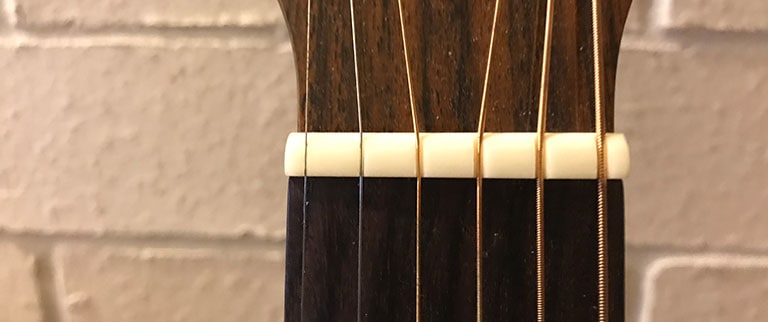In the following article, we’re going to discuss what nut width is on your acoustic guitar and how it affects playability. We’ve also included a handy comparison chart showing the nut widths of some of the more popular acoustic guitars available today, so you can make a direct comparison.
The average nut width on the acoustic guitar is 1 11/16” or 43mm. Some acoustic guitars feature nut widths as wide as 1 7/8” or more. Nut width refers to the width of the nut, which resides at the end of the fretboard nearest the headstock. Nut width dictates the string spacing at the open position on the fretboard (the first four frets).
What is Nut Width
If you’re shopping around for your first guitar something you may want to consider is nut width. Nut width is the term used to describe the width of the nut, the white plastic, bone, or graphite component on your acoustic guitar that separates the fretboard from the headstock.
The nut is slotted at different depths to allow for the different string gauges. The strings sit within these grooves and the distance between them dictates just how much string separation there is between the strings at the nut.
A wider nut offers more separation between the strings at the headstock end of the neck, while a narrower nut means the strings are closer together. This does not mean nut width dictates the string spacing of the guitar as a whole, as the neck tapers and the saddle is wider than the nut and therefore is spaced more widely at the saddle.
Is nut width the same as neck width?
Some incorrectly refer to nut width as neck width, but this is a more general term that incorporates nut width, string spacing, and fretboard width.
If you look down the neck of your guitar, you will notice the neck taper increases as you continue along the neck toward the higher frets, nut width does not directly relate to neck width, although they are often used interchangeably.
Are nut width and string spacing the same thing?
No, nut width refers to the width of the nut only, string spacing refers to the distance between the strings. And, while a wider nut width often equates to a wider string spacing in the open position (the first four frets), specific nut widths don’t relate to specific string spacings. Both can vary, so the relationship between the two is more general. Indeed, guitars with wider nut widths will often also have wider than average string spacings but there’s no defined standard.
String spacing at the headstock end of the guitar is determined by the nut width but the string spacing gets wider (typically about 10% wider) the further along the neck you go and the closer you measure in proximity to the saddle, as the saddle of the guitar is wider than the nut.
String spacing, as a result, is measured directly at the saddle, or in other instances, and for different manufacturers, this measurement is taken at the 14th fret.
How is Nut Width Measured
Nut width is usually measured in inches, usually as a fractional measurement e.g. 1 3/4“.
It’s sometimes shown in decimals e.g. 1.750“ or millimeters e.g. 44.5mm (rounded up from 44.45mm)
| Fractional | Decimal | MM |
| 1 ¾” | 1.750” | 45mm |
When measuring nut width, measure from outside edge to outside, not the distance between the low E and high E nut slots, as this is a measurement of string spacing.
Measure using a reliable steel ruler or if available a set of digital calipers.
Common nut widths on steel-string acoustic guitars
There isn’t a standard nut width for steel-string acoustic guitars. Manufacturers build guitars based on their own standards but an average nut width would normally be close to 1 11/16” or 43mm.
However, as you can see on the comparison chart below, nut widths vary, catering to a wide range of players with different preferences.
The list below includes guitars of all price ranges, including the Martin D28 through to the less expensive Epiphone DR100. The different specifications have been listed as either fractional or decimal, depending on which makes more sense as a format for the given nut width.
| Guitar | Nut Width |
| Martin D-28 | 1-11/16″ and 1 3/4″ (changed to 1 11/16” in 1939) |
| Martin D-18 | 1 3/4″ |
| Taylor 414CE | 1 3/4″ |
| Epiphone DR100 | 1.68″ |
| Martin LX1 | 1 11/16″ |
| Yamaha FG800 | 1 11/16″ |
| Taylor GS Mini | 1 11/16″ |
| Gibson G-45 Standard | 1.725″ |
| Seagull S6 | 1.72″ (may vary) |
| Fender Sonoran | 1.69″ |
| Blueridge BR-160 | 1 11/16″ |
| Yamaha APX600 | 1 11/16″ |
| Takamine GD93 | 1.6875″ |
| Guild M120 | 1.7″ (42.8mm) |
| Fender Tim Armstrong Hellcat | 1 11/16″ |
| Breedlove Solo Concert | 1.89″ |
| Epiphone Hummingbird Pro | 1.68″ |
| Alvarez Artist Series AF30 | 1 3/4″ |
| Washburn WCG55CE | 1 3/4″ |
acoustic guitars with 1 7/8 nut width
You are more likely to find a 1 7/8″ nut width on 12-fret guitars (the neck joins the body at the 12th, instead of the 14th fret), especially older Martins e.g. 0 and 00 28vs. A nut width this wide is usually seen on fingerstyle guitars as this facilitates a wider string spacing which accommodates playing with the fingers.

The Blueridge BR-341 is a more current model with 1 7/8″ nut width.
Classical Guitar Nut Width
As the table above indicates, nut width for steel-string acoustic guitars can vary. However, in the classical guitar world, the standard nut width is 2″ or 51mm. This is changing, however, as newer classical guitars from brands such as Cordoba (often referred to as crossover guitars) incorporate a narrower 1 7/8″ nut width.
How does nut width affect how the guitar plays?
Nut width is important. If you are looking for a new guitar, chances are you have preferences concerning the brand, body shape, tonewoods, particularly the soundboard, perhaps the neck profile, and of course how the guitar sounds and plays.
Nut width also plays an important role concerning playability because it has an immediate impact on the playability of the guitar, particularly for your fretting hand.
e.g. if you are anything like me with larger than average fingers a wider nut width is useful, as your hand will feel less cramped, allowing you to play more cleanly, especially in the open position as you are less likely to fret unwanted notes.
On the other hand, many guitarists prefer a narrower nut width, especially those with a smaller hand span as it makes reaching the individual strings much easier. It just comes down to personal preference, your physical limitations, and your approach to the guitar.
Do different genres matter?
It’s commonly thought that nut width is important with regard to your approach to the guitar e.g. do you play mostly with a pick or play fingerstyle. But for the most part nut width is less important than string spacing as nut width mostly affects the fretting hand and not the picking hand.
However, the two are often mentioned in the same breath as typically a guitar with a wider nut width will also feature a wider string spacing. However, the string spacing is not necessarily just wider because the nut itself is wider.
Unlike string spacing which mostly influences the picking hand, nut width relates most strongly to the fretting hand and dictates the distance between the strings closer to the nut only.
Summary
Nut width, string spacing, scale length, and neck profile are all equally important, but perhaps even more so is how these relate to one another, and ultimately how the guitar then feels to play. That’s why if you are in the market for a new guitar ~ if you can, it’s best if you can test out the guitar by playing it before buying.



